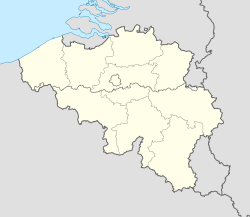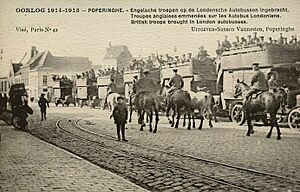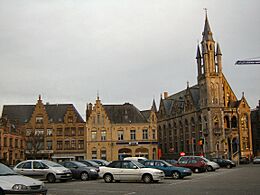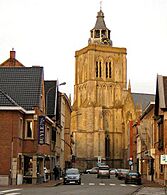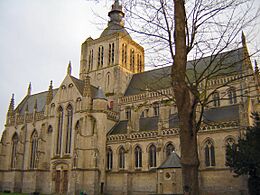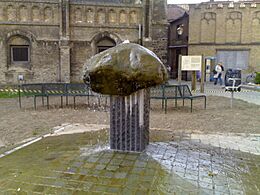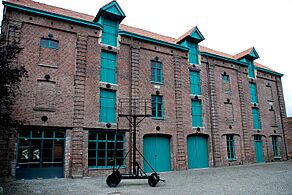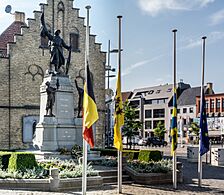Poperinge facts for kids
Quick facts for kids
Poperinge
|
|||
|---|---|---|---|
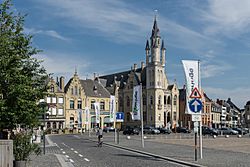
Street banners welcome visitors to Poperinge's Town Hall and Grote Market
|
|||
|
|||
| Country | Belgium | ||
| Community | Flemish Community | ||
| Region | Flemish Region | ||
| Province | West Flanders | ||
| Arrondissement | Ypres | ||
| Area | |||
| • Total | 119.33 km2 (46.07 sq mi) | ||
| Population
(2018-01-01)Lua error in Module:Wd at line 1575: attempt to index field 'wikibase' (a nil value).
|
|||
| • Total | Lua error in Module:Wd at line 1,575: attempt to index field 'wikibase' (a nil value). | ||
| Postal codes |
8970, 8972, 8978
|
||
| Area codes | 057 | ||
| Website | www.poperinge.be | ||
Poperinge is a city and municipality in Belgium. It's located in the West Flanders province, which is part of the Flemish Region. This area has a history that goes way back to the Middle Ages! Poperinge is famous for growing hops, which are used to make beer, and for its beautiful lace.
Contents
Discovering Poperinge City
Poperinge is about 13 kilometers (8 miles) west of Ypres (also called Ieper). This region is super important for growing hops. In fact, it produces 80% of all the hops in Belgium!
The city even has a national hop museum. That's why it's often called "hops city," or hoppe stad in Dutch. This is a fun play on words, as hoofd stad means capital city. Every three years, Poperinge hosts a big hop festival and parade in September. The local beer brewed here is called Hommel, which means hops in the local dialect.
Historic Churches and Bells
The oldest church in Poperinge is called Sint-Bertinuskerk. Its carillon (a musical instrument made of bells) was once known as one of the most beautiful in Flanders during the Middle Ages. Sadly, it was destroyed during a war in 1677 but was later fixed up in 1781.
How Poperinge is Organized
Besides the main town of Poperinge, the municipality also includes several smaller villages. These are called "submunicipalities" or "deelgemeenten." They include Krombeke, Proven, Reningelst, Roesbrugge-Haringe, and Watou.
There are also two smaller areas called Abele and Sint-Jan-Ter-Biezen. These don't have the same "deelgemeente" status because they weren't independent towns before Belgium merged many municipalities in the 1970s.
- Roesbrugge-Haringe is actually two separate villages: Roesbrugge and Haringe.
- The hamlet of Abele is special because it's right on the border with France, so part of it is actually in France!
The municipality of Poperinge shares its borders with many other small villages and even some French towns.
A Look Back at Poperinge's History
People have lived in the Poperinge area for a very long time, even since the Neolithic period (the New Stone Age). During the time of the Roman Empire, a road was built connecting Poperinge to other important places.
In the 7th century, during the time of the Franks, the area was known as Pupurningahem. It became connected to the church in Saint-Omer. In 1147, the Count of Flanders, Dietrich of Alsace, gave Poperinge a special charter. This helped the town grow and become a busy center for making cloth. To make room for more people, two new churches, Saint John and Our Lady, were built in 1290.
The "Cobble-Heads"
In 1322, a ruler named Louis de Nevers tried to stop cloth-making outside of Ypres. The people of Poperinge didn't like this, as it hurt their business. They joined a revolt against him the next year. They kept finding ways around the rules, showing how determined they were. Because of their strong resistance, they earned the nickname keikoppen, which means "cobble-heads." This name was first used in 1341 when the Ypres army attacked Poperinge.
Times of Trouble and War
During the Hundred Years War, Poperinge faced many challenges. The Counts of Flanders sometimes supported France, which stopped the wool trade with England. This caused more revolts. In 1382, French troops attacked and burned the town. Then, in 1436, an English army did the same.
In 1513 and again in 1563, large parts of Poperinge were destroyed by fires. During this time, the town also supported the Protestant movement and took part in the Beeldenstorm (a period when religious images were destroyed). All this fighting and persecution really hurt the town and its trade.
Things got even tougher with wars between the French and the Dutch over who would control the region. Poperinge changed hands several times:
- In 1678, it became French by the Treaty of Nijmegen.
- In 1697, it returned to Spanish control by the Treaty of Ryswick.
- In 1713, it was given to the Austrians by the Treaty of Utrecht.
- In 1794, revolutionary France took it over.
- After Napoleon's defeat, it became part of the United Kingdom of the Netherlands.
- Finally, in 1830, Belgium became independent.
Since then, Poperinge has become successful again by focusing on growing hops, which first started in the 15th century.
Poperinge During World War I
During World War I, Poperinge was one of only two towns in Belgium that the German army did not occupy. It became a safe place for British troops to stay and for field hospitals to treat wounded soldiers. Soldiers often called it "Pop."
It was just behind the front lines and was a very important place for soldiers and their families. A famous rest house called Talbot House (or "Toc H") offered a place for soldiers to relax. You can still see reminders of this time in the town hall, like special rooms where soldiers were kept, and a historical post in the courtyard.
Many military cemeteries are located around Poperinge. These cemeteries hold the graves of soldiers from Canada, Britain, Australia, France, Germany, the U.S., and even the Chinese Labour Corps. One of these is Lijssenthoek Military Cemetery, where soldiers who were wounded near Ypres and later died in Allied hospitals are buried.
Getting Around: Transportation
Poperinge railway station is the end of Belgian railway line 69. This line used to go all the way to Hazebrouck in France until the 1950s. Today, trains run hourly from Poperinge to Kortrijk and Antwerpen.
Poperinge in Books and Poems
Poperinge has been mentioned by some famous writers!
- The English poet Geoffrey Chaucer wrote about a Flemish knight from Poperinge in his Canterbury Tales.
- About 150 years later, John Skelton mentioned Poperinge in his poem "Speak Parrot."
The town also has connections to several poets who wrote in Latin.
- Jacques May (Jacobus Majus) was born in Poperinge and wrote a Latin poem in 1563.
- Later, Maximiliaan de Vriendt wrote a poem praising Poperinge and its churches.
- Gislain de Coninck, another poet from Poperinge, translated Latin poems.
- In the 17th century, two more Latin poets, Joannes Bartholomaeus Roens and Petrus Wenis, were from the town. Wenis wrote about a miracle in 1479 where a still-born child came back to life. This event is still celebrated today!
In more recent times, the French poet Charles Baudelaire mentioned Poperinge in one of his works. And the Canadian poet W. W. E. Ross wrote a poem called "Poperinghe 1917."
Famous People from Poperinge
- Dirk Frimout (born 1941): He was Belgium's first astronaut! The town park is named after him.
- Anne Provoost (born 1964): A well-known Flemish novelist.
Friendship Cities
Poperinge has "twin towns" or "sister cities" around the world. This means they have special friendly relationships with these places:
 Frielendorf, Germany
Frielendorf, Germany Hythe, England, United Kingdom
Hythe, England, United Kingdom Rixensart, Belgium
Rixensart, Belgium Wolnzach, Germany
Wolnzach, Germany Žatec, Czech Republic
Žatec, Czech Republic
Gallery
See also
 In Spanish: Poperinge para niños
In Spanish: Poperinge para niños



